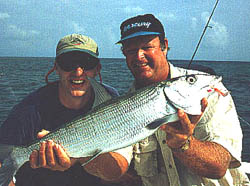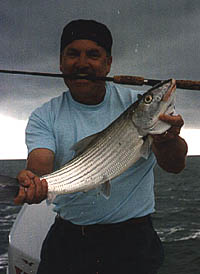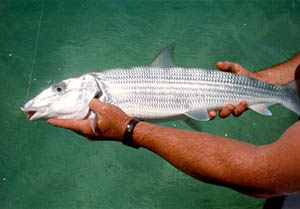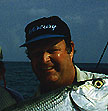 Part of the
Part of theFISHING THE FLORIDA KEYS
Series
Florida Keys Bonefishing
 Part of the
Part of the
FISHING THE FLORIDA KEYS
Series
Non-traditional tactics can work wonders on bonefish during unfavorable winter weather conditions in the Florida Keys.
SITE LAST UPDATED 9/8/99
 "Well, I guess this
front is going to ruin our bonefishing today," said my chagrined angler, as we stood
together on the dock staring into the windswept expanse of Florida Bay. His
disappointment was well founded; he had traveled a pretty fair distance from the extreme
northern portion of the world (Wisconsin or New York or someplace) down to the tropical
climes of the Florida Keys in order to escape...you guessed it...cold windy weather.
"Well, I guess this
front is going to ruin our bonefishing today," said my chagrined angler, as we stood
together on the dock staring into the windswept expanse of Florida Bay. His
disappointment was well founded; he had traveled a pretty fair distance from the extreme
northern portion of the world (Wisconsin or New York or someplace) down to the tropical
climes of the Florida Keys in order to escape...you guessed it...cold windy weather.
A January cold front had torn through the Keys the day before, and the high pressure
system that had built in behind it was pummeling us with a twenty knot (and gusting) wind.
Furthermore, temperatures had dropped from the mid seventies down to the upper fifties
(which is bonechilling if you live here year 'round).
However, it was not the air temperature that concerned us, but rather the corresponding
drop in water temperature on the flats. Although this was to be his first trip with me, my
prospective angler was no slouch when it came to knowing his quarry, or the conditions
under which they are normally caught. Not only had he been catching bonefish for
years in both the Keys and the Bahamas, but he had also devoured just about every piece of
literature ever written on the subject. So when I suggested that conditions were
just right for great winter-time bonefishing, the look on his face bordered somewhere
between shock and suspicion. I'm sure he thought he was about to get
"hustled."
Bonefishing usually involves the guide poling a boat quietly across a shallow flat while both he and the angler search for bonefish. Once a bonefish is spotted and is within range, the angler is called upon to make an accurate cast. If the bait lands too far from the fish, he'll never see it. If the bait lands too close, the spooky fish will bolt off the flat in terror. If the bonefish eats the offering, an angler will experience one of the fastest first runs in all of fishing.
This is classical bonefishing at its best, a game of absolute precision
and to many, the epitome of catch and release angling. Yet, not all bonefishing is done in
this manner. Conditions such as high winds, heavy cloud cover, or higher stages of
the tide warrant a change in tactics. Or perhaps an angler's casting skills aren't
up to snuff for sight casting to spooky "tailers." Florida Keys guides
have perfected a method whereby the boat is anchored or staked out on a section of flat
along which bonefish are known to travel. A handful of diced-up shrimp is then
tossed behind the boat. Once the smell of the shrimp wafts down current from the
boat, any bonefish swimming through the "chumline" almost always will follow the
scent to its source. Then an angler can make an easy downwind cast to the fish (if
he didn't already have the bait laying in the chumline in the first place).
Countless anglers have caught their first bonefish using this method.
A Break with Tradition
Both of these styles of bonefishing are based on the presumption that there will be
bonefish on the flat. However, when water temperatures dip below a certain point (about 70
degrees for the Keys), bonefish will leave the flats for the sanctuary of deeper, warmer
water. And although everything you've ever read about the subject states that
blustery winter cold fronts are not synonymous with good bonefishing, there is, in fact, a
very good chance of catching bonefish provided you're willing to make a radical departure
from normal tactics. Savvy Keys' guides have been using this method for years to
find fish for their winter clients.
Make no mistake...fishing for bonefish in cold water is not to be confused with normal
sight casting on a flat. First of all, you are fishing "blind," casting
not at a particular target, but rather into a general area. Secondly, you are not
even up on a flat per Se; instead, the water you are fishing ranges from about four to six
feet deep. And finally, rather than spending the day charging around the backcountry
of Florida Bay, efforts are concentrated just off the ocean-side flats from Key Biscayne
all the way down to Key West. These flats provide bonefish with quick access to
deeper warmer water during a cold snap. And because the ocean side is basically a lee
shore during the northerly winds of a cold front, anglers reap the benefit of relatively
comfortable fishing conditions in even a twenty knot wind.
Locating the Fish
 The first order of business when it comes to finding cold
water bones is to locate a "mud." Muds are a discoloration in the water
caused by sediments being stirred up by fish rooting around on the bottom for food.
The mud may be the size of a flats skiff, or it may be as large as a house. I'll
often spend a good deal of time hunting for a mud before we ever wet a line. And
sometimes it's possible to get fooled; what looks like a good bonefish mud may turn out
(after fishing it) to be a patch of muddied water created by a deep draft boat that chose
this spot to jump up on a plane twenty minutes before. Even a stingray can churn up a
sizable area of bottom, making you think you've found a hot mud. I'll invest about
twenty minutes on a mud...if we haven't hooked a bone by then I'm usually out of there.
The first order of business when it comes to finding cold
water bones is to locate a "mud." Muds are a discoloration in the water
caused by sediments being stirred up by fish rooting around on the bottom for food.
The mud may be the size of a flats skiff, or it may be as large as a house. I'll
often spend a good deal of time hunting for a mud before we ever wet a line. And
sometimes it's possible to get fooled; what looks like a good bonefish mud may turn out
(after fishing it) to be a patch of muddied water created by a deep draft boat that chose
this spot to jump up on a plane twenty minutes before. Even a stingray can churn up a
sizable area of bottom, making you think you've found a hot mud. I'll invest about
twenty minutes on a mud...if we haven't hooked a bone by then I'm usually out of there.
Some days the fish will lay right off the edge of the flat and the muds will be in four to
six feet of water. During times of extreme cold, you may have to work them in water
as deep as 8-10 feet! Bonefish are more likely to mud on deep-water grass than on large
expanses of white sand. The grass not only holds crustaceans better, but some feel
the darker grass absorbs some heat from the sun, making dining all the more comfortable
for the bones. Our most productive fishing has usually come between the hours of
11AM and 3 PM, no doubt due to the warming effects of the sun on the water.
Fishing a Mud
Once a mud is located, care must be taken not to disturb the bonefish in it. The
general rule is to cut the engine 75 to 100 yards upwind of the mud, and then pole or
drift in toward it. The boat is then staked out with the push pole, or if it's
fairly deep, the anchor is quietly slipped over the side.
Having the boat positioned several boat lengths upwind of the mud, the next order of
business is to chum. I'll typically dice up about a dozen shrimp and toss them out
behind the boat to help concentrate the fish in one area, adding more shrimp tidbits as
needed. When things get busy and we're hooking up regularly, we really go through
some shrimp in the course of a trip, so I like to carry 15-20 dozen for a day's fishing.
I like two basic rigs when fishing deep-water bones. The first is a whole shrimp,
Texas rigged on a 2/0 sliced shank hook with a split shot just above the knot. The
other is a 1/4 oz pink jig sweetened with a thumbnail size piece of shrimp. I'll
have my clients cast into the mud just beyond the point where the chum was tossed in.
Then they'll slowly twitch and retrieve their offering so it hops along the bottom.
For tackle, a light seven foot spinning outfit holding at least 175 yards of 10 pound mono
is about right. It goes without saying that drags must be silky smooth to weather
the long, powerful runs of a hooked bonefish.
Flyfishing for these deep water bonefish can also be quite productive. Although many
would balk at the idea of trying to sling a flyline around in a twenty knot wind, it's
really not as bad as it sounds, as all of the casts will be made to a point that is only
about one and a half boat lengths directly downwind. A 9 or 10 weight outfit is
appropriate for these conditions, and although an angler might get away with a floating
line with a long leader and weighted fly, a much more effective presentation can be made
with an intermediate flyline (the slow sinking mono core lines are an excellent choice).
My most effective patterns have been the McVay Gotcha and a chartreuse and white
Clouser Deep Minnow, both with heavy lead eyes on a #1 34007 Mustad hook.
The retrieve (once the fly has been allowed to sink) should be in quick four to six inch
ticks. The fly should be fished deep enough so that an angler occasionally feels it hang
momentarily in the turtle grass.
Two Common
Problems

Hooking a large bonefish while staked out on a productive mud presents another problem
(albeit a pleasant one). Because of the deeper water and the howling wind, trying to
pole the boat in pursuit of a "reel screamer" isn't very effective, and starting
the motor would spook the rest of the fish in the mud. Sometimes I just have to
cross my fingers and hope my angler can turn the fish before running out of line.
When there's over 100 yards of 8 or 10 lb test out there attached to a large fast-moving
bonefish, plenty can go wrong. Seafans, lobster trap lines, and floating seaweed,
are just some of the things the line can get hung up on during an extended battle with a
bone.
Just what kind of action can you expect from winter bonefishing? Frankly, it's
possible to post some pretty impressive numbers considering the conditions. Several
local guides reported days with 15 to 20 bonefish landed on 8 hour trips last winter, and
my best day to date is landing 14 out of 16 bonefish hooked. Although we're talking
extremes here, it does demonstrate what kind of potential is out there off the edge of the
flat during those cold fronts. For a figure that might be more representative of an
average day, regular catches are made of a half dozen bonefish or more per trip. The
bonefish themselves average about three to five pounds, although 8 to 10 lb fish are not
uncommon while fishing blind in a mud. Double headers are frequent when you find a
hot mud, and the furious action, though usually short-lived, reminds me of bailing
schoolie dolphin on a weed line, what baiting jigs, dicing and tossing chum, and netting
and releasing fish.
From time to time, those winter muds will also produce some "surprise guests,"
the most welcome of which is the feisty permit. Though they are loners at this time
of the year and not of the size that will be around in the spring, these 10 - 15 lb.
permit do have a way of livening things up for an angler. Other "bonus" catches
include small tarpon, pompano, mutton and mangrove snapper, jack crevelle, big blue
runners, and sharks.
Conclusion
Interestingly enough, not everybody enjoys fishing "blind" for bonefish in deep
water. No doubt some anglers, being addicted to the thrill of the hunt, will never
be happy targeting bonefish by any other means than shallow water stalking and sight
casting. Some purists might even carry it one step further, feeling that catching a
bonefish without first seeing and stalking it somehow dishonors the fish and the sport
(like catching an Atlantic Salmon on an earthworm suspended under a bobber). The
purpose of this article is not to quibble over preferences, but rather to demonstrate that
a viable fishery exists in the Keys for bonefish even during the cold fronts that often
make up a good portion of the weather in December, January and February. Far from
being the death knell of productive bonefishing, winter cold snaps can provide fast and
fairly consistent action for those willing to vary their tactics to suit the demands of
the existing weather conditions.
![]()
About the Author
 Captain Buddy LaPointe is a cum
laude graduate of Pensacola Christian College, and has over 20 years experience charter
fishing in the Florida Keys. He has been featured on Mark Sosin's Saltwater
Journal, (seen weekly on national television), and in the Outdoors section
of the Miami Herald. In addition, Capt. Buddy has written
numerous articles for Sport Fishing Magazine, Saltwater
Sportsman, Fishing the Florida Keys, and the Florida
Keys Keynoter.
Captain Buddy LaPointe is a cum
laude graduate of Pensacola Christian College, and has over 20 years experience charter
fishing in the Florida Keys. He has been featured on Mark Sosin's Saltwater
Journal, (seen weekly on national television), and in the Outdoors section
of the Miami Herald. In addition, Capt. Buddy has written
numerous articles for Sport Fishing Magazine, Saltwater
Sportsman, Fishing the Florida Keys, and the Florida
Keys Keynoter.
![]()
|
HOMEPAGE | ARTICLES | EMAIL/FEEDBACK |